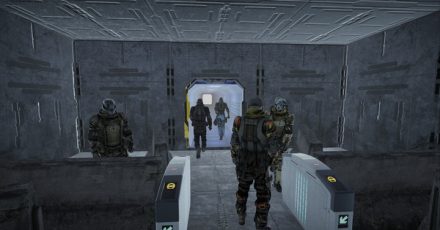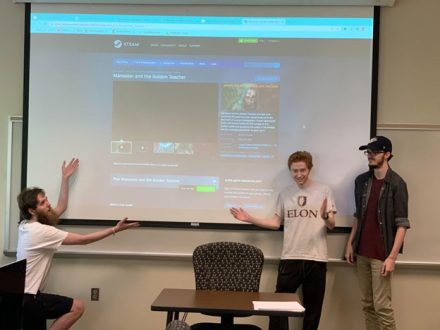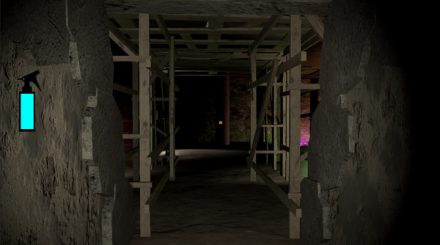Students in the interdisciplinary minor’s capstone courses developed three games in 2022 and published them on Steam.
A ghost-filled murder mystery, a post-apocalyptic world fueled by mind-altering drugs and a quest to restore music to the world are the premises of the first games released by Elon’s Game Design Minor.
Students in the minor capstone developed and released “Maneater and the Golden Teacher” “Soul Janitor” and “Harmony Overture” on Steam, a popular game distribution platform, this month. The games are free to play.

“It’s a thrill seeing what you’ve made out there for everyone to try out and play,” said Rafael Pico ’22, a journalism major. “It was a fun experience making it, working with peers to make something we could be proud of. It was a lot of hard work but personally very rewarding.”
The interdisciplinary Game Design Minor launched in 2019 and teaches students to study, design and implement computer games. In addition to a four-course foundation in game design, production and collaborative development, the program includes electives in art, music, English and communication.
The two-semester capstone course challenges students to devise a game with team members then prototype, play test and refine it for release. This winter and spring, students from majors including computer science, cinema and television arts, English, professional writing and rhetoric, and communication design collaborated on the games.

The J-term and spring semester capstone courses simulate a professional game-development and studio-culture experience, said Assistant Professor of Computer Science Pratheep Paranthaman, the minor’s coordinator. Teams, or “studios,” use the Scrum project management method to deliver a finished product in a short time.
“Students come from different backgrounds and with different skills and have to work together to achieve the goal of developing and releasing a game in four months,” Paranthaman said. “They have to negotiate with their teammates and convince them of their ideas, all while understanding their strengths and playing on them in the development process.”
Team roles included level designers who plan the flow of the game; narrative designers who tell a story through game mechanics; environmental designers who support the game and story through the setting and features; and technical designers who write scripts and programming.

But before any screens or controllers were involved, games begin with objectives, rules, story lines and the discernment of which style of game-play best suits them. The goal is to create a memorable playing experience.
“First, you have to have an idea that’s interesting for a game, that works and holds water,” Pico said. “Then you plan it, begin development and start testing it.”
Pico’s team created “Harmony Overture,” a music-themed 2D rogue shooter style game where the main character, Melody, battles monsters and armies with musical instruments she collects through different levels. The goal is to bring music from the underground world to the world above ground, where it is illegal.
Pico served as a level designer and managed communications for the team. He plans to pursue a journalism career reporting for gaming publications.

Logan LaMont ’23 was part of the team that created “Maneater and the Golden Teacher,” which he described as a “visual novel, point-and-click style game.” The team built the game from an original story by a group member, written for an English class, about a post-apocalyptic world. Players must venture to retrieve resources to survive, including a kind of hallucinogenic mushroom called “the golden teacher.”
“Once we had our initial story, we looked to other popular and successful games as inspiration for ideas and mechanics to incorporate into our game,” LaMont said. “That’s the start of the game process, then you add simple things to the design at first before you build it up in an iterative process and keep improving it every few weeks.”
LaMont served as audio engineer, handling music and sound effects, along with secondary design tasks. He appreciated the opportunity to create a narrative story and use his computer science-major skills in less technical and mathematical ways.

The team that developed “Soul Janitor” began by challenging themselves to create a first-person shooter-style game without using guns or bullets. They developed a game where players are a janitor tasked with cleaning up a haunted warehouse and solving a murder mystery with only a spray bottle and mop to defend themselves.
Throughout the process, students had to meet Steam’s specifications and publishing deadlines.
“These students are pioneers,” Paranthaman said. “Game design is basically problem solving. Each team had unique design problems they solved to achieve their goals. Seeing your students achieve is the best experience you can have as a teacher.”



